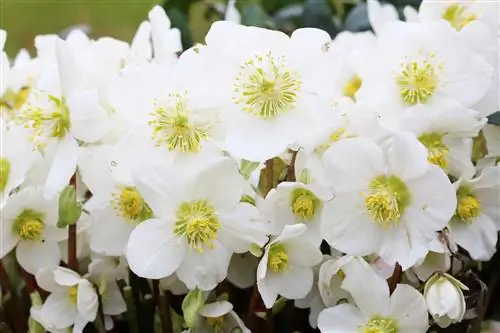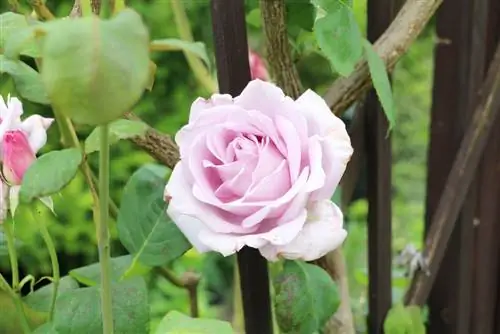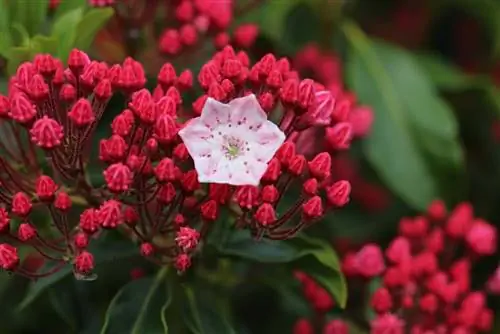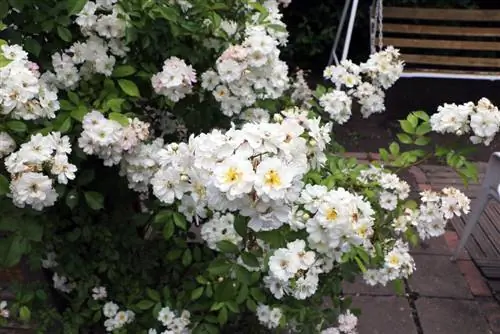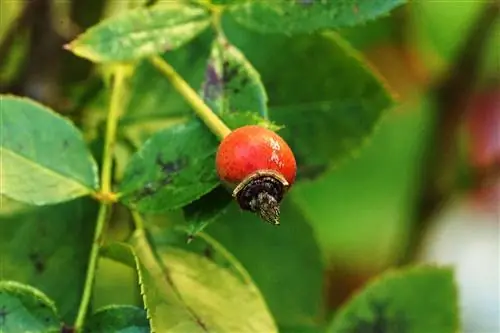- Author admin [email protected].
- Public 2023-12-17 03:39.
- Last modified 2025-01-24 12:45.
Christmas roses are among the plants that look good both in the garden and in a plant pot. A Christmas rose blooming at Christmas is a particularly beautiful sight and is why it is so popular. The Christmas rose, its Latin name is Helleborus niger, is also called hellebore or snow rose. It is one of the hardy, evergreen plants that are perennial. The Christmas rose belongs to the buttercup family, which is usually quite easy to care for. With proper care and an ideal location, a hobby gardener can enjoy it for up to 25 years and it reaches a size of around 30 centimeters. The snow rose blooms in the garden from January to April. But there are also modern varieties that begin to bloom in December. Their color depends on the breeding. Originally it was native to the Alps and some parts of the Balkans and was white in color.
Appearance of the Christmas rose
The snow rose usually grows between 10 and 30 centimeters high. The long-stemmed, fanned leaves sit on the rhizomes of the powerful rootstock. The leaves of Christmas roses are leathery, insensitive and have a rich green color. It produces very beautiful flowers, but the evergreen leaves are also a pretty eye-catcher.
The flower itself is mostly white and cup-shaped, and symmetrically arranged. They stand on an unbranched stem two fingers' width above the leaves and have a diameter of 5 to 5 centimeters. Flowering lasts from December to early April, but depends on the weather, altitude and amount of snow. As it fades, the color of the flower changes. It can be cut out to produce a new flower, otherwise Christmas roses will self-seed.
The Christmas roses in the planter
For optimal growth, a snow rose always needs enough space, whether in the garden or in a planter. The best time to plant Christmas roses in the garden is early autumn so that they can get used to their surroundings. This also makes it more resistant to frost. If it has been planted in a container, it is entirely possible to bring it into the house around Christmas time. However, this interference with the nature of the snow rose usually becomes apparent later. If you still want to bring them into the house, you should put them in a place that is as cool as possible. In addition, it should be returned to its usual environment after Christmas, but this should be done gently and not during a period of frost, which would be very damaging to the plant.
The right location in the garden for Christmas roses
A Christmas rose thrives best on loamy, calcareous soils, although the subsoil should be permeable to water, as it doesn't like to get 'wet feet'. She also doesn't like direct sunlight. The location you should choose, for example, is a place under a deciduous tree. This means the snow rose gets enough light, but not strong sunlight. For the winter months, the gardener can help it a little by protecting it against the hard frost. Your root ball can be protected from hard frost by a fleece or coconut mats. You can also use Styrofoam, which also has an insulating effect.
Caring for a Christmas rose
Caring for a snow rose is actually unnecessary, as it thrives best when left alone. An experienced hobby gardener will occasionally add a little lime to her soil to do her some good. This is particularly recommended if there are coniferous trees in the area that can acidify the soil. Pruning after flowering is not necessary, but it usually results in it sprouting again quickly. Sometimes it makes sense to shorten the leaves a little so that the Christmas rose stands out better. However, in order to propagate them, the flowers should stay on. They then go wild and sow themselves.
Christmas roses are poisonous
As pretty as the snow rose is to look at, it is one of the poisonous plants. It can cause dangerous symptoms of poisoning in humans and animals. If you have free-roaming pets, it is better to avoid planting Christmas roses altogether or to place them so that the animals cannot reach them.
Optimal conditions for a Christmas rose
- It can be placed in the garden or in a planter if it has enough space
- The snow rose is highly poisonous, so it should be kept out of reach of animals and children
- best planting time in the garden is early autumn
- best location under a deciduous tree as it doesn't like direct sun
- she prefers clayey, calcareous soils
- no waterlogging!
- hardly any care needed
- Pruning possible for new flowers
- It multiplies wildly without pruning
Conclusion
The Christmas rose is a beautiful plant that shows its most beautiful side in winter. Their disadvantage is clearly their great toxicity. Their advantages lie in the undemanding nature and low care requirements of Christmas roses. In addition, Christmas roses can grow extremely old if they are placed in the right location.
Requirements regarding location & care
- In home gardens, the plants feel particularly comfortable in front of shrubs and between taller trees and come into their own very well there, but the Christmas rose also looks good in borders.
- The soil should be rich in nutrients and humus and contain lime. The Christmas rose prefers a semi-shady to shady place. The Christmas rose can thrive under forest-like conditions. Regular and constant tillage of the soil should definitely be avoided, as the plant cannot tolerate this.
- Occasional doses of lime can promote flower setting and growth. When the fruit clusters of the Christmas rose are fully ripe, they sow themselves.
Christmas rose: common diseases
The Christmas rose is actually one of the easy-care plants, but two diseases are often observed. One is the fungal leaf spot and the other is a rot at the base of the leaf stems.
The Christmas rose contains the glycoside helleborine, which can cause symptoms of poisoning in larger doses. If the skin comes into contact with the plant sap, this can potentially lead to skin irritation.
23 gardening tips
The Christmas rose blooms from December and is usually in full bloom right around Christmas. The creamy white flowers shine out of the uniform gray of the garden. They last a long time and require little care. The plants can live for 25 years or more. Christmas roses are not just a symbol of hope for Christians. Attention: Christmas roses are poisonous in all parts!!!
Location
The best location is under a deciduous tree. This means that the Christmas rose has partial shade in summer and enough light in winter.
The falling leaves enrich the soil with humus.
Christmas roses don't like overgrown neighbors such as hostas!
Planting substrate
- Helleborus love humus, loamy soils
- Waterlogging must be avoided at all costs!
- Christmas roses grow better when planted than in pots. Freshly purchased plants can be left potted during the Christmas season and then planted in the bed.
- The beautiful flowering plants are only suitable to a limited extent as houseplants. It is too warm for them indoors and they wither quickly.
- Planting takes place in early spring as soon as the ground is no longer frozen.
- The Christmas rose is a deep-rooted plant. She doesn't like being transplanted.
Watering and fertilizing
- During the flowering period, the plant needs sufficient water.
- Standing moisture must be avoided at all costs!
- You should keep Christmas roses dry in summer! While all the other plants around are being watered, the Christmas roses should be left out. Only freshly planted specimens need a little water now and then.
- There is no need to fertilize as long as the soil is nutrient-rich.
- If you want to fertilize (especially in very light, sandy soils), you can use horn shavings or bone meal.
Cutting
- Only the stems and leaves are cut. You cut it off at the base!
- As soon as the shoot tips of the flowers appear, you can remove the remaining leaves (you don't have to). This way the flowers have space and all the energy is put into flower formation.
- The Christmas rose is propagated by division or sowing.
- Seeds must be harvested very early, as soon as the fruits turn yellow-green and can be easily opened!
- The seeds germinate in light, so do not cover them with soil!
- The offspring are not pure, but still very beautiful.
- The Christmas rose can also be propagated by dividing a perennial or plant.
Diseases and pests
Black spot disease occurs very frequently. Therefore, the leaves should be checked regularly for black spots. If these occur, the leaves must be removed and disposed of (not in the compost)!
Aphids sometimes appear as pests. Otherwise the plants usually remain undisturbed.
Conclusion
The Christmas rose is a beautifully flowering plant. It blooms exactly when there is not much to see in the garden. Once you have found a suitable location, you can enjoy the flowering plants for decades. They are often quite expensive to buy, but are worth buying if you plant them in the garden later.

